 |
STANDARD
SR-H505 Japan 1961 |
 |
 English
English |
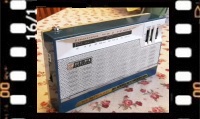 |
Italiano  |
|
|
|
|||
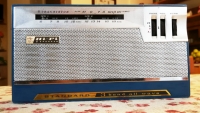 |
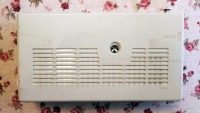 |
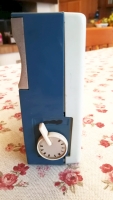 |
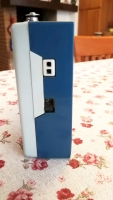 |
 Standard SR-H505 - Standard Radio Corp. (SR) - Tokyo, Japan - 1961.
Standard SR-H505 - Standard Radio Corp. (SR) - Tokyo, Japan - 1961.Japanese portable radio from the early 1960s that used eight transistors and received three frequency ranges: Medium Wave (540 to 1600 kHz), Short Wave 1 (6 to 12 MHz), and Short Wave 2 (12 to 18 MHz). The circuit was a superheterodyne using eight germanium transistors: 2SA70, 2SA101, 2SA101, 2SB175, 2SB175, 2SB175, 2SB156, 2SB156, and three OA70 germanium diodes, and the intermediate frequency resonated at 455 kHz. The AM and SW antenna was wound on an 7.086 in long ferrite core, but for shortwave reception, the whip antenna located on the upper right side of the cabinet had to be pull up. A copy of the diagram can be seen here. The radio was called Hi-Fi because the 0.3 watts supplied by the audio amplifier, using the push-pull operation of the two 2SB156s, were fed to a system of two parallel speakers, one 3.5 inc and the other 3 inc, both 8 Ohms. This solution, however, produced a loud and clear sound, certainly better than otherJapanese pocket radios of the time. The cabinet was made of plastic with an aluminum grille on the front. The dial was silkscreened on the metal, and through a large slot, protected by a transparent plastic strip, two sliding indexes were visible, which were moved by the tuning knob. The tuning control was located on the right side of the panel, along with the tone and volume controls. The three reception bands were selectable via a switch on the right side of the cabinet, while the left side contained the power switch and two jacks for headphones or an external speaker. The SR-H505 was powered by three 1.5 V D-type (LR20) batteries. The radio's dimensions were 9.5 x 5.2 x 2 in, and it weighed 3 lb 4.9 oz with batteries inserted. Like many other Japanese-produced receivers sold on the U.S. market during the Cold War, the SR-H505's dial was also silkscreened with two triangles corresponding to the two Medium Wave frequencies used by the CONELRAD nuclear attack warning system, then in use in the United States. (Click here for more information). To restore the tri-band Standard to working order, I had to replace all the electrolytic capacitors, to replace the tuning cord, and use deoxidizing spray on the potentiometers and band selector. I adjusted my multi-voltage power supply to 4.5 VDC and connected it to the radio in place of the three batteries, then I was able to listen to some stations on Medium and Short wave. © IK3HIA 2025. |
|||
|
|
|||
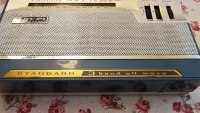 |
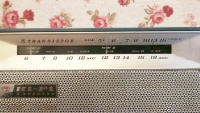 |
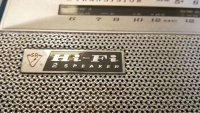 |
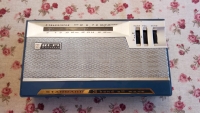 |
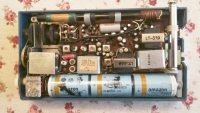 |
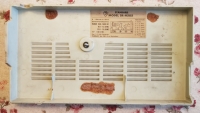 |
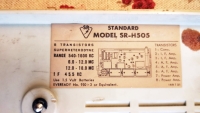 |
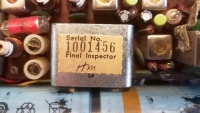 |
 Standard SR-H505 - Standard Radio Corp. (SR) - Tokyo, Giappone - 1961.
Standard SR-H505 - Standard Radio Corp. (SR) - Tokyo, Giappone - 1961.Radio portatile giapponese dell'inizio degli anni '60 che utilizzava otto transistor e riceveva tre gamme di frequenze: Onde Medie (da 540 a 1600 Khz), Onde Corte 1 (da 6 a 12 MHz) e Onde Corte 2 (da 12 a 16,7 MHz). Il circuito era una supereterodina che impiegava 8 transistor al germanio: 2SA70, 2SA101, 2SA101, 2SB175, 2SB175, 2SB175, 2SB156, 2SB156 e tre diodi al germanio OA70, e la media frequenza risuonava a 455 KHz. L'antenna per le OM e le OC era avvolta su un nucleo di ferrite lungo 18 cm ma per la ricezione nelle onde corte era necessario estrarre l'antenna a stilo posta sulla parte superiore destra del mobiletto. Qui è visibile una copia dello schema elettrico. La radio era definita Hi-Fi perché gli 0,3 Watt forniti dall'amplificatore audio con il push-pull dei due 2SB156, venivano applicati a un sistema di due altoparlanti posti in parallelo, uno da 9 cm / 3.5 inc e l'altro da 8 cm / 3 inc, entrambi da 8 Ohm. Questa soluzione comunque dava come risultato un suono forte e chiaro, sicuramente migliore di quello delle radioline giapponesi tascabili dell'epoca. Il mobiletto era in plastica con il frontale abbellito da una griglia di alluminio, la scala parlante era serigrafata sul metallo e attraverso una larga fessura, protetta da una striscia di plastica trasparente, erano visibili due indici scorrevoli che erano mossi dalla manopola della sintonia. Il comando era posto sulla parte destra del pannello assieme a quelli del tono e del volume. Le tre bande di ricezione erano selezionabili tramite il commutatore posto sul lato destro del mobiletto, sul lato sinistro invece era situato l'interruttore di accensione e due prese per cuffia o altoparlante esterno. L'alimentazione della SR-H505 era fornita da 3 batterie torcia da 1,5 V tipo D (LR20). Le dimensioni della radio erano: 24 x 13 x 5 cm / 9.5 x 5.2 x 2 inc e il peso era di 1.5 kg / 3 lb 4.9 oz con le batterie inserite. Come molti altri ricevitori prodotti in Giappone e venduti sul mercato U.S.A. durante la Guerra Fredda, anche sulla scala parlante dell'SR-H505 erano serigrafati due triangolini in corrispondenza delle due frequenze delle Onde Medie utilizzate dal sistema di allerta per attacco atomico CONELRAD, all'epoca in uso negli Stati Uniti. (Clicca qui per ulteriori informazioni). Per ripristinare il funzionamento della Standard tribanda ho dovuto sostituire tutti i condensatori elettrolitici, la funicella di sintonia e usare lo spray disossidante sui potenziometri e sul commutatore di banda. Ho regolato il mio alimentatore multitensione a 4,5 Vdc e l'ho collegato alla radio al posto delle 3 batterie e ho potuto ascoltare alcune stazioni sulle Onde Medie e sulle Onde Corte. © IK3HIA 2025. |
|||
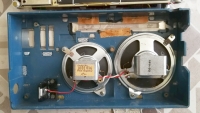 |
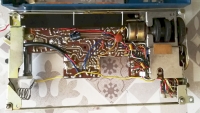 |
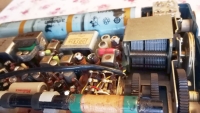 |
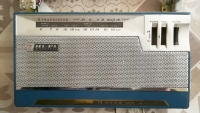 |
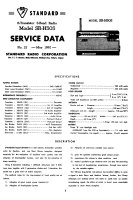 |
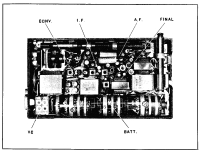 |
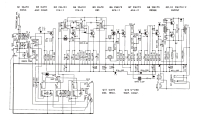 |
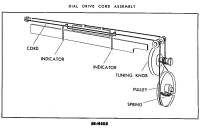 |
|
Return to top of
page
|
|||
|
|
Return to: IK3HIA home page |
|
Return to: Transistor Radio |
|
Go to: Transistor diagrams |